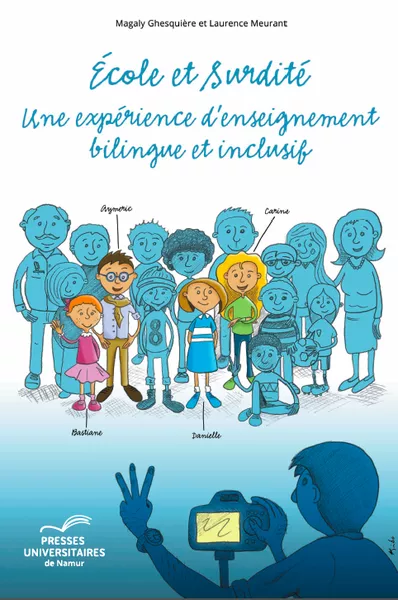
UNamur is a pioneer in the field of linguistic studies of French-speaking Belgian sign language (LSFB). The LSFB-Lab is unique in Belgium. It works closely with the ASBL École et surdité and the Centre scolaire Sainte-Marie Namur, which has included groups of deaf children in hearing classes since the beginning of the year 2000, offering these pupils a bilingual education.
The book "Ecole et surdité"
This book transmits the experience developed for more than twenty years by the teaching team of these classes. It shows that teaching deaf and hard-of-hearing children has many specificities, both in relation to the education of hearing children and in relation to other bilingual teaching arrangements. The primary target readers are teachers, interpreters, teaching assistants or communication aids who work with one or more deaf children and who wish to take a step back from their work.
This book, published by the Presses Universitaires de Namur (PUN) in 2018, received the prize for the best book for Teaching and Continuing Education from the Parliament of the Wallonia-Brussels Federation, awarded every two years. It is awarded by a jury composed of specialists from various backgrounds: the Book Council, the Academy, the Youth Council, the Education Inspectorate, teaching staff, the Higher Council for Continuing Education, the Association of Belgian French-speaking Writers and, of course, Members of Parliament.
The authors
Magaly Ghesquière trained as a teacher. She was the first teacher to join the bilingual classes of Sainte-Marie in Namur. Between 2012 and 2017, she worked as a pedagogical assistant at the Laboratoire de langue des signes de Belgique francophone (LSFB-Lab) of the University of Namur in order to describe, transmit and improve the experience of this unique school system in Belgium. Since 2021, she has continued this collaboration with the LSFB-Lab for a second research phase. She is attached to the Namur Institute of Language, Text and Transmediation (NaLTT).
Laurence Meurant is a linguist, qualified researcher of the F.R.S.-FNRS at the University of Namur and president of the NaLTT Institute. She is the director of the Laboratoire de Langue des signes de Belgique francophone (LSFB-Lab) where she developed the first discourse studies on LSFB and on the comparison between French and LSFB. In partnership with the Faculty of Computer Science (the teams of Prof. A. Cleve, Prof. B. Frénay and Prof. B. Dumas), she initiated the development of digital tools to promote bilingualism and the visibility of LSFB (see below). Since 2004, she has been involved in the supervision of teachers in the inclusive bilingual classes described in this book.
A new inter-university certificate in French and Belgian Sign Language
The experience and research gathered in this book are the subject of one of the specialisations of the new inter-university certificate "Langue des signes de Belgique francophone et français: enseignement, bilinguisme et pratique de l'interprétation par les sourds".
The proposed training aims to share the experience of professionals in the field of the mastery and teaching of LSFB, in the field of bilingual teaching of deaf students, and in the practice of interpretation and translation by the deaf.
The certificate is carried out by the University of Namur in partnership with the University Saint-Louis of Brussels and, thanks to an Erasmus+ project, in collaboration with the University of Toulouse. It will take place from February 2023 to June 2024.
This is the first training course in French-speaking Belgium to be entirely designed in sign language and for the deaf public.
More information about the certificate in French and Belgian Sign language
A new bilingual sign language-French dictionary
Laurence Meurant is also part of the interdisciplinary team that has just created the first bilingual French-sign language (LSFB) contextual dictionary, which was put online last October. This dictionary has the double particularity of giving access to signs and words in different contexts of spontaneous use, and of being able to be questioned in sign language in front of a simple webcam. This pioneering tool is the result of four years of intense work by a team of researchers in linguistics and computer science at the UNamur, a team that is not only interdisciplinary but also inter-generational, with senior profiles (academics and post-doctoral fellows), and quite junior (students). The team is also inclusive, as hearing and deaf people have been involved in this project since the beginning. A world first that offers a powerful, easy-to-use tool that is freely accessible to a wide audience: deaf children, their families, teachers, translators and interpreters.